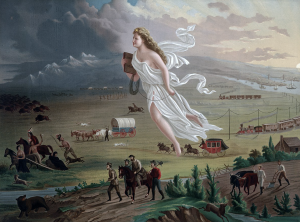Exploitation and Entitlement
The painting below illustrates the themes of the manifest destiny period. The puritans, who had recently won the revolutionary war (and had further secured that win in 1812), believed that they had a duty to spread their country and ideals at least as far as the Pacific Ocean. The angelic female brings light to the dark, Native-ridden land to the west, as the Natives desperately attempt to flee the onslaught of pioneers. Following closely behind the pioneers are the farmers, upon whom we will mainly focus. Close behind those farmers we see the railroads, bringing in more people, more citizens to take over the land, and more farmers who do not know the first thing about farming.

(Gast)
Americans believed that they were racially and culturally superior. This mentality underpinned the events of the Dust Bowl. Along with spreading their notions of capitalism and democracy, Americans’ divisiveness surrounding slavery intensified. In the mid 19th century, close to 200,000 slaves were thought to have aided the American expansion westward.
The American idealism surrounding manifest destiny resulted in brutal war with both Native Americans and Mexico (Pratt). The Treaty of Guadalupe Hidalgo ended the Mexican-American War in 1848 and added 525,000 square miles to the western U.S. There was more land to settle, more farming land, and a vast base of inexperienced farmers.
At the same time, the notion of Manifest Destiny had to do with white-Americans. There was an inherent white supremacy that came with the Western expansion. This colonialist-like mindset cemented itself in American philosophy, and although the exact mentality of Manifest somewhat died with the conclusion of westward expansion, there were remnants of the philosophy that could still be seen during the events of the Dust Bowl. As victims early 20th century disaster fled Westward, they were met with the inherent superiority of the also-white Californians. The lofty mindset that guided the brutal actions of white Americans against Native Americans was retained and later cast upon fellow white Americans.

(Photographer unknown. Photo c. 1936)